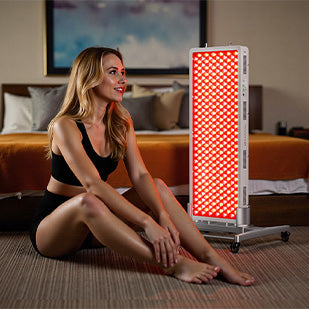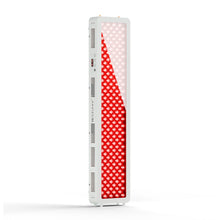If you feel the need to get healthier and are looking for the best treatment options out there, then you might have heard about Red light therapy (RLT) and Infrared Sauna (IRS). They both provide unique benefits through different mechanisms, though picking one over the other can be puzzling. Here’s a breakdown of the science, protocols, and practical considerations of each to guide your ability to choose wisely on your wellness journey.
The Fundamentals of Red Light Therapy and Infrared Saunas: What you need to know
What is Red Light Therapy (RLT)?
Red Light Therapy uses certain, low-level wavelengths of light, usually from the red to near-infrared spectrum. This light penetrates the skin and subdermal tissues to stimulate cellular energy production in your mitochondria—the powerhouse of the cell. It was believed that this could help elevate cellular energy production, thereby assisting healing and rejuvenation processes [1].

What is an Infrared Sauna (IR)?
Unlike traditional saunas, infrared saunas use light waves that penetrate deeply into tissues, heating the body directly rather than the surrounding air. This deep penetration triggers a similar strong sweat at lower temperatures than traditional saunas, enabling intense detoxification and circulation, making it easier on the body.
Health Benefits Explored: How Each Therapy Interacts with the Body
Targeted Benefits of RLT
The benefits of red light therapy can be especially pronounced when it comes to skin health and muscle tissue. Regular usage is said to improve skin elasticity, reduce wrinkling, fade scars, and heal wounds faster. Athletes and fitness enthusiasts often use RLT to expedite recovery post-workout by reducing inflammation and muscle soreness, thus enhancing overall physical performance.
Thermal Effects of IRS
Infrared Saunas work mainly on thermal mechanisms. IRS increases blood flow, improves cardiovascular health, and detoxifies the body, along with copious sweating, when you raise your core body temperature. The deep heat helps clear toxins, relieve stress, alleviate chronic muscle pain, and improve sleep quality by promoting deep relaxation.

Unpacking the Wellness Benefits: Potential Gains from RLT and IRS
Shared Potential Benefits
One thing that Red Light Therapy and Infrared Saunas have in common is similar benefits, especially when it comes to stress relief and relaxation. Whether you’re using RLT to target muscle soreness or an infrared sauna to help promote relaxation, both therapies reduce the body’s overall tendency to stress. Frequent applications of either therapy could also enhance the quality of sleep due to activation of the parasympathetic nervous system, which induces calm and recovery [2].
Distinctive Advantages
However, each therapy also has unique benefits. RLT is known to be particularly effective for skin health and targeted cellular rejuvenation and is often used to treat conditions like acne, psoriasis, and even hair loss. Meanwhile, the signature advantage of the IRS is detox, as well as cardiovascular benefits, through intense sweating, which has natural benefits for those looking for all-around internal cleansing and circulatory support.
Key Differences Compared: Application, Experience, and Mechanisms
Targeted Light vs. Deep Heat
The main difference between Red Light Therapy and Infrared Saunas is how they administer their individual therapy sessions. RLT involves specific wavelengths of light that target areas in the body. Usually, an RLT session will use handheld devices or panels that can be driven near the skin, often targeting a more specific problem area like a wound, muscle strain, or skin condition.
On the contrary, an Infrared Sauna is a full-body experience. The heat wraps around you, warming your body and creating a visceral sweat. IR sessions usually consist of sitting or lying in a sauna-like chamber in which infrared light permeates the skin from all sides, providing full-body treatment. This experience lasts anywhere from 15 to 45 minutes, depending on individual tolerance and goals.
User Experience and Session Structure
RLT sessions are shorter and more targeted. Depending on the device, sessions last about 10 to 20 minutes. It's a low-impact, non-sweat-inducing option—ideal for targeting specific issues without full-body treatment.
Infrared Saunas, on the other hand, require a longer commitment. It runs for 20–45 minutes, and people are put into an intense environment. The super-charged hotness of IRS sessions can take some getting used to, especially for people who aren't familiar with heat-based therapies, but many find their experience more pleasant since the sessions involve infrared warmth.
Tailoring Your Choice: Aligning Technology with Personal Wellness Goals
Assessing Your Health Priorities: Acute Issues vs. Overall Wellbeing
The decision between these two therapies should start with some reflection on your health priorities. Are you seeking targeted relief for immediate issues, like improved skin health or specific muscle pain? If so, RLT’s more specific, concentrated approach may work well for you.
On the other hand, if you are interested more broadly in detoxification, cardiovascular improvement, stress relief, or deep relaxation, opt-in for Infrared Saunas: a full, therapeutic experience of wellness conducive to whole body health.
Practical Considerations for Integration
Along with therapeutic preferences, practical factors also come into play. Keep in mind that Red Light Therapy devices require minimal space, and sessions can easily fit into a busy schedule. This means RLT is possible even for people with small spaces and very busy schedules.
Infrared Saunas, on the other hand, usually require either a designated space at home or regular trips to a wellness complex. On average, each IRS session takes more time, and the more demanding experience may require a higher heat tolerance. So, assessing your home environment and lifestyle, and whether you feel physically comfortable with heat exposure, is paramount in your decision.
Making Your Wellness Journey Personal
Both Red Light Therapy and Infrared Saunas have their advantages — but which one you go for really depends on your wellness goals! Both therapies can make for effective tools in enhancing your well-being, whether you are looking for targeted relief from specific skin and muscle conditions or a full-body detox and relaxation experience. Choosing the therapy that works best for your personal wellness journey can be possible by evaluating your goals, personal preferences, and practical needs. You can select the therapy that best suits your wellness journey by assessing your goals, preferences, and practical needs.
Sources and References
- Jagdeo J, Nguyen JK, Ho D, et al. Safety of light-emitting diode-red light on human skin: Two randomized controlled trials. J Biophotonics. 2020;13(3):e201960014. https://doi.org/10.1002/jbio.201960014
- Do infrared saunas have any health benefits? Mayo Clinic. https://www.mayoclinic.org/healthy-lifestyle/consumer-health/expert-answers/infrared-sauna/faq-20057954















 Small
Small

 Moderate
Moderate

 Moderate
Moderate

 Moderate
Moderate

 Full
Full



